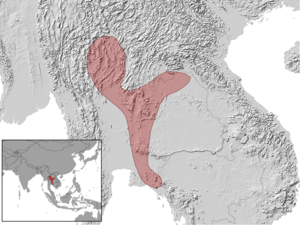Banded supple skink facts for kids
The banded supple skink (Lygosoma haroldyoungi) is a type of lizard. It's also called Harold's writhing skink or Harold Young's supple skink. This skink belongs to the Scincidae family, which is a group of lizards known as skinks. It lives only in Southeast Asia, meaning it's found nowhere else in the world.
Quick facts for kids Banded supple skink |
|
|---|---|
| Conservation status | |
| Scientific classification | |
| Genus: |
Lygosoma
|
| Species: |
haroldyoungi
|
 |
|
| Geographic range of Lygosoma haroldyoungi in Southeast Asia. | |
| Synonyms | |
|
|
Contents
Why is it Called Haroldyoungi?
The second part of its scientific name, haroldyoungi, honors a man named Harold Young. He was an American missionary. Harold Young worked in countries like Burma (now Myanmar) and Thailand. He also started the famous Chiang Mai Zoo.
Where Does the Banded Supple Skink Live?
The banded supple skink lives in Southeast Asia. You can find it in northern, central, and eastern Thailand. It also lives in nearby Laos and Myanmar.
Skink Locations in Thailand
In Thailand, these skinks have been seen in many areas. Some of these include Chachoengsao, Chiang Mai, and Nakhon Ratchasima provinces.
Skink Locations in Laos
In Laos, they are found in Vientiane Province.
What Kind of Home Does it Like?
The banded supple skink lives in tropical forests. These are forests where trees lose their leaves during part of the year. It can also be found in areas where people grow crops. These skinks usually live at altitudes between 100 and 500 meters (about 330 to 1,640 feet) above sea level.
What Does the Banded Supple Skink Look Like?
When fully grown, the banded supple skink is about 11.5 to 14.8 centimeters (4.5 to 5.8 inches) long. This measurement is from its snout (nose) to its vent (the opening near its tail). It has four legs, but they are all very short.
What Does the Banded Supple Skink Eat?
This skink is a predator, meaning it hunts for its food. Its diet mainly includes earthworms and various types of insects.
How Does it Reproduce?
Scientists are still learning about the banded supple skink. Right now, we don't know how this species reproduces.
Is the Banded Supple Skink in Danger?
The banded supple skink faces some threats, mainly from losing its natural home. This happens when forests are cut down or changed. However, this is not a huge problem for the skink. It can still survive in areas where people farm. This means it's not as threatened as some other animals.


